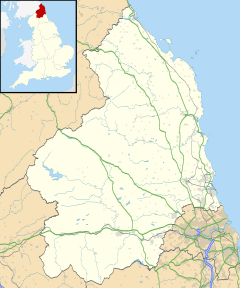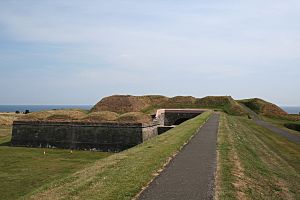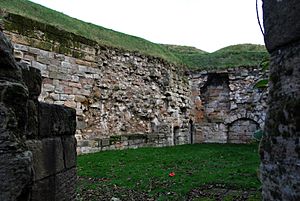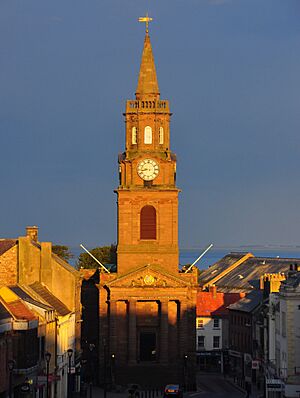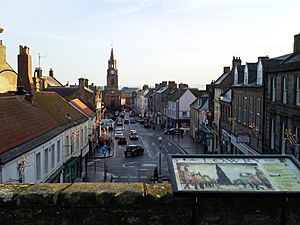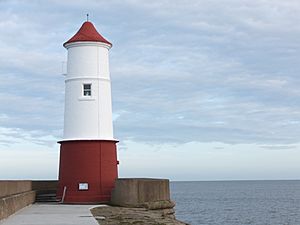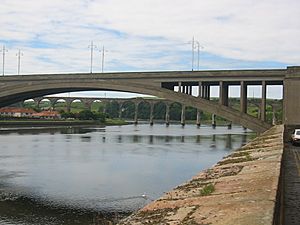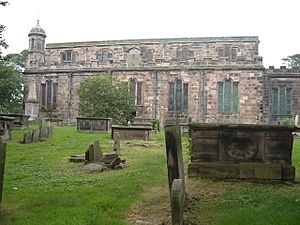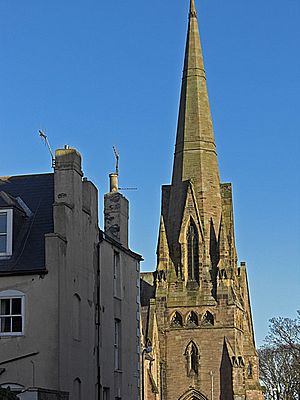Berwick-upon-Tweed facts for kids
Quick facts for kids Berwick-upon-Tweed |
|
|---|---|
 Berwick-upon-Tweed behind its defensive walls |
|
| Population | 12,043 (2011 Census) |
| OS grid reference | NT995525 |
| • London | 304 mi (489 km) |
| Civil parish |
|
| Unitary authority |
|
| Ceremonial county | |
| Region | |
| Country | England |
| Sovereign state | United Kingdom |
| Post town | BERWICK-UPON-TWEED |
| Postcode district | TD15 |
| Dialling code | 01289 |
| Police | Northumbria |
| Fire | Northumberland |
| Ambulance | North East |
| EU Parliament | North East England |
| UK Parliament |
|
| Website | Berwick-upon-Tweed Town Council |
Berwick-upon-Tweed (![]() i/ˈbɛrɪk/), often called Berwick, is a town in Northumberland, England. It is about 2.5 miles (4 km) south of the border with Scotland. This makes it the northernmost town in England. In 2011, about 12,043 people lived there.
i/ˈbɛrɪk/), often called Berwick, is a town in Northumberland, England. It is about 2.5 miles (4 km) south of the border with Scotland. This makes it the northernmost town in England. In 2011, about 12,043 people lived there.
The town sits at the mouth of the River Tweed on England's east coast. It is about 56 miles (90 km) south-east of Edinburgh and 65 miles (105 km) north of Newcastle upon Tyne. Berwick is even further north than Denmark's capital, Copenhagen.
Berwick started as an Anglo-Saxon settlement in the Kingdom of Northumbria. This area became part of England in the 10th century. Today, Berwick is a civil parish with its own town council. This council also includes the nearby areas of Spittal and Tweedmouth.
For over 400 years, Berwick was a key spot in the wars between England and Scotland. It changed hands many times. The last time England took control was in 1482. Even today, many people from Berwick feel a strong connection to Scotland. For example, both Berwick Rangers Football Club and Berwick Rugby Football Club play in Scottish leagues.
Berwick is still a traditional market town. It has many interesting old buildings. These include its medieval town walls, its Georgian Town Hall, and Britain's oldest barracks. The famous architect Nicholas Hawksmoor designed the barracks between 1717 and 1721.
Contents
What's in a Name?
The name Berwick comes from an old English word, berewíc. This word meant "corn farm," especially a farm for barley. It was also used for a piece of farmland separate from a main estate. The earliest time we see the name written down was in 1167 as Berewich.
There are other places in Britain with similar names, like North Berwick in Scotland. In the past, Berwick-upon-Tweed was sometimes called "South Berwick" by Scottish people. The town's old seal even showed a bear and a wych tree. This was a playful way to show its name, like a pun.
Berwick's Story
Early Times
After the Roman Empire, the area around Berwick was home to the Brython people. Later, it became part of the Anglian kingdom of Bernicia. Bernicia then joined with another kingdom to form Northumbria. In the mid-10th century, Northumbria became part of the Kingdom of England.
Berwick was part of the Earldom of Northumbria until Scotland took control after the Battle of Carham in 1018. The town itself began as an Anglo-Saxon settlement during the time of Northumbria.
Scottish Town
Between the late 900s and early 1000s, the land between the rivers Forth and Tweed came under Scottish rule. David I, who was king from 1124 to 1153, made Berwick a royal burgh. This meant it was an important town with special rights. David also set up many of Scotland's counties, and Berwick became the main town of Berwickshire. By 1153, Berwick even had its own mint to make coins.
When it was under Scottish control, Berwick was sometimes called "South Berwick." This helped people tell it apart from North Berwick, which is near Edinburgh.
A Disputed Place
Berwick was in a very important spot on the Anglo-Scottish border. Because of its location and wealth, it was often attacked and taken over. For centuries, England and Scotland fought over it.
In 1173–74, William I of Scotland tried to take northern England. After he lost, Berwick was given to Henry II of England in 1174. This was part of the Treaty of Falaise. But in 1189, William paid Richard I of England a lot of money, and Berwick went back to Scotland.
By the mid-1200s, Berwick was a very rich town. One bishop said it was "so full of people and so important for trade that it could rightly be called another Alexandria."
In 1292, Berwick was where Edward I of England decided who would be the next Scottish king. He chose John Balliol.
In 1296, England went to war with France, and Scotland was France's ally. Balliol invaded England, and Edward I then invaded Scotland. He captured Berwick, destroyed much of the town, and killed many of its people.
Edward I returned to Berwick in August 1296. About 2,000 Scottish nobles came to show their loyalty to him. This happened after Edward defeated the Scots and forced John Balliol to give up his crown. Around this time, work began on building the town walls and rebuilding the castle. These strong defenses were finished by 1318.
In 1314, Edward II of England gathered 25,000 soldiers at Berwick. These soldiers later fought in the big defeat at the Battle of Bannockburn. Between 1315 and 1318, Scottish armies attacked Berwick. They finally captured it in April 1318.
England took Berwick back in 1333, right after the Battle of Halidon Hill. The Scots briefly took control of the town again in 1355, but the English quickly took it back in 1356. In 1461, Berwick was given back to Scotland by Margaret of Anjou. She did this to get help against the Yorkists in the Wars of the Roses.
In 1482, Richard, Duke of Gloucester (who later became Richard III), recaptured the town for England. The Scots never got control of Berwick again. Over about 400 years, Berwick had changed hands more than a dozen times!
English Town
Much of southern Scotland was invaded by England again between 1543 and 1551. This war ended with the Treaty of Norham in 1551. England kept Berwick, and the town was declared a free town, independent of both kingdoms. But in practice, England controlled it.
During the time of Queen Elizabeth I of England, a huge amount of money was spent on Berwick's defenses. These new fortifications were built in an Italian style, designed to resist cannons. They are described as "the only surviving walls of their kind."
Berwick stopped being a border fortress when England and Scotland joined under one king. On April 6, 1603, James VI of Scotland crossed the border to become James I of England. He was met at Lamberton by the governor of Berwick. In December 1603, the soldiers in Berwick were greatly reduced.
In 1639, the army of Charles I met the Scottish army at Berwick. They did not fight, but instead signed the Pacification of Berwick.
The Berwick Bridge, also called the "Old Bridge," was built in 1611. It connected the two sides of the River Tweed. Holy Trinity Church was built between 1648 and 1652. It is the most northern church in England. It was built with special permission from Oliver Cromwell.
British Town
In 1707, the Act of Union joined England and Scotland to create the Kingdom of Great Britain. Since then, Berwick has been part of England's legal system. A law from 1746 said that if a law mentioned England, it also applied to Berwick.
Until the 1830s, Berwick's town boundaries were only on the north side of the River Tweed. But Tweedmouth, on the south side, had grown a lot. In 1832, Berwick's parliamentary area was expanded to include Tweedmouth and Spittal. A few years later, the town's council boundaries were also expanded to include them. Berwick became an independent county corporate.
In the 1840s, Berwick was listed in both English and Scottish dictionaries. It remained a county on its own until 1885. Then, it became part of Northumberland for parliamentary purposes. In 1889, Berwick came under the control of Northumberland County Council.
Today, England officially includes Berwick. In 2009, the Borough of Berwick-upon-Tweed was ended. All its duties were given to Northumberland County Council.
How Berwick is Governed
When Scotland controlled Berwick, it was the main town of Berwickshire. This means Berwickshire was the only county in Britain named after a town in another country!
In 1958, Berwick's council asked the Scottish heraldic authority for a coat of arms. They got one, "as suitable to a Burgh of Scotland."
On April 1, 2008, a new Town Council was created for Berwick-upon-Tweed. It covers Berwick, Tweedmouth, and Spittal. This council took over the old Borough's traditions and symbols, like the mayoralty. The mayor for 2022–2023 was Mike Greener.
Berwick-upon-Tweed is part of the North Northumberland area for the parliament.
Berwick's Economy
More than 60% of people in Berwick work in the service sector. This includes jobs in shops, hotels, restaurants, and healthcare. In the past and present, Berwick has had jobs in salmon fishing, shipbuilding, and making things like tweed fabric.
Berwick town centre has many local shops and some larger chains. There is also a new office building near the library.
In Tweedmouth, there is a retail park with several big stores. In 2008, Tesco got permission to build a new store, which opened in 2010. Asda also took over a Co-op shop in Tweedmouth.
A Morrisons supermarket, McDonald's, Travelodge UK, and Aldi are located on Loaning Meadows, near the A1 road. The Aldi store moved to a new retail park there. This new park also has KFC, Costa Coffee, a Food Warehouse, Greggs, and Home Bargains.
Getting Around Berwick
The old A1 road goes through Berwick. The newer A1 road now goes around the town to the west. Berwick is on the East Coast Main Line railway, and it has its own Berwick-upon-Tweed railway station.
A small port at Tweedmouth helps with importing and exporting goods. It does not have passenger services. A long breakwater built in the 1800s protects the port. At the end of it is a red and white lighthouse. This lighthouse was finished in 1826 and sends out a white light every five seconds.
Bus services are mainly run by Borders Buses and Arriva. They offer both local and longer trips. National Express coaches also serve the town.
Berwick's Culture
Berwick's Identity
Berwick is known for its unique identity. Some people strongly feel they are English, loyal to Northumberland. Others feel a connection to Scotland. Because Berwick is right on the border, many people have family from both England and Scotland. This mix helps create a special "Berwicker" identity.
Historian Derek Sharman said, "The people of Berwick feel really independent. You are a Berwicker first, Scottish or English second." A former mayor, Mike Elliot, said that 25% of the town sees themselves as English, 25% as Scottish, and 50% as Berwickers.
In 2008, a Scottish politician suggested Berwick should become part of Scotland again. Another politician, Jeremy Purvis, who grew up in Berwick, even asked for the border to be moved south. He said, "There's a strong feeling that Berwick should be in Scotland." However, the local MP at the time said this would be a huge legal change and not realistic.
Berwick's Dialect
The way people speak in Berwick-upon-Tweed has parts of both Northumberland dialects and Scottish accents. In 1892, a linguist named Richard Oliver Heslop put the Berwick dialect in the "north-Northumbrian" group. This area stretched from Berwick down to the River Coquet.
One feature of this dialect is the "Northumbrian burr," a special way of saying the letter R. Older people in Berwick might have a slight burr, but younger people usually do not.
A study in 2000 found that people south of Berwick thought the Berwick accent sounded Scottish. But people north of Berwick, in Scotland, thought Berwick speech sounded English.
Sports in Berwick
Berwick Rangers Football Club started in 1881. The club plays in the Scottish football league system. Their home stadium is Shielfield Park. Berwick Rangers currently play in the Lowland League, which is the fifth level of Scottish football.
The town also has a rugby union team, Berwick RFC. They play in Scottish Rugby Union's East Regional League Division 1. Until 2016, these two teams were unique because they were English teams playing in Scottish leagues.
A newer team, Tweedmouth Rangers Football Club, has played in the East of Scotland Football League since 2016. Their home ground is Old Shielfield Park.
Speedway racing has also happened in Berwick. The sport came to Shielfield Park in 1968. The team, called the Bandits, has raced at different levels of speedway.
Media
Local news and TV shows come from BBC North East and Cumbria and ITV Tyne Tees. Because Berwick is close to the Scottish border, you can also get BBC Scotland and ITV Border channels.
The town's local radio stations are BBC Radio Newcastle on 96.0 FM and Greatest Hits Radio on 102.3 FM.
Berwick-upon-Tweed's local newspaper is the Berwick Advertiser.
Berwick and Russia
There's a fun story that Berwick is (or was) officially at war with Russia. The story says that in 1966, a reporter from a Russian newspaper visited Berwick's mayor. They supposedly made a declaration of peace. The mayor said, "Please tell the Russian people... they can sleep peacefully in their beds."
The story goes that the declaration of the Crimean War in 1853 mentioned "England, Scotland and the town of Berwick-upon-Tweed." But when the peace treaty was signed in 1856, Berwick was left out. This supposedly meant Berwick was still at war! In reality, Berwick was not mentioned in either the war declaration or the peace treaty. It was legally part of the United Kingdom the whole time.
Education
Like the rest of Northumberland, schools in Berwick use a three-tier system. This means there are first schools, middle schools, and high schools. Some students might also go to secondary schools across the Scottish border in Eyemouth or Berwickshire.
First schools
- Berwick St Mary C of E
- Holy Island C of E
- Holy Trinity C of E
- Hugh Joicey C of E
- Lowick
- Norham St Celwulfs C of E
- Scremerston
- Spittal Community School
- St Cuthbert's RC
- Tweedmouth Prior Park
- Tweedmouth West
Middle schools
- Berwick Middle School
- Tweedmouth Community
High schools
- Berwick Academy
Independent schools
- Longridge Towers School (for all ages, boys and girls)
Special schools
- The Grove School
Twin Towns
Berwick-upon-Tweed is twinned with:
- Berwick, Pennsylvania, United States
- Berwick, Victoria, Australia
- Haan, Germany
- Sarpsborg, Norway
- Trzcianka, Poland
Famous Landmarks
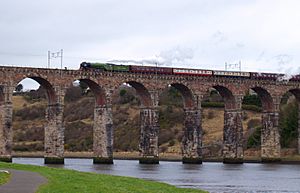
- Berwick Castle was built in the 1200s. Much of it was taken down in the 1800s to make way for the railway. But you can still see many ruins near the town walls.
- Berwick town walls and Tudor ramparts are some of the best examples of old defenses in the country.
- The Old Bridge is a long stone bridge with 15 arches. It was built between 1610 and 1624. It still carries road traffic, but only in one direction.
- Holy Trinity Parish Church was built between 1648 and 1652. It is the most northern parish church in England. It was built using stone from the old castle.
- Berwick Barracks were built from 1717 to 1721. Their design is thought to be by Nicholas Hawksmoor.
- Berwick Town Hall was designed by S&J Worrell and built between 1754 and 1760. It's a neoclassical building. The top floor used to be the town's prison.
- Dewars Lane Granary was built in 1769. It has been restored and is now a hotel and art gallery.
- Marshall Meadows House, built in 1780, is north of the town. It is the most northern hotel in England, very close to the Scottish border.
- Union Chain Bridge, about 5 miles (8 km) upstream from Berwick, was built in 1821. It is the world's oldest surviving suspension bridge.
- The Kings Arms Hotel on Hide Hill was built in 1782. The famous writer Charles Dickens stayed there in 1861.
- The Royal Border Bridge was designed by Robert Stephenson. It was built from 1847 to 1850. It's a long railway viaduct with 28 arches, carrying the railway 126 feet (38 m) above the River Tweed. Queen Victoria opened it.
- The Corn Exchange was finished in 1858. It was turned into apartments in the late 1990s.
- St Andrew's Church, Wallace Green, was built in 1859. It is one of only eight Church of Scotland churches in England.
- The Masonic Hall was built in 1872. It is still owned by the town's Masonic Lodge. It has a large pipe organ built in 1895.
- The Royal Tweed Bridge was built in 1925 to carry the A1 road over the Tweed. At the time, its main span was the longest concrete span.
- Dewars Lane is a street that was painted by the famous artist L. S. Lowry, who visited Berwick.
- There are many sea caves along the coast north of Berwick. Some are up to 67 meters long.
Notable People
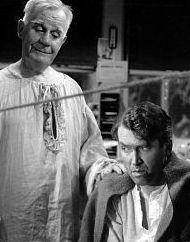
- Torben Betts, an award-winning writer, lives in Berwick.
- Lucy Bronze, a famous footballer for Barcelona and England, was born in Berwick-upon-Tweed.
- Jessie Greengrass, an author, lives in Berwick-upon-Tweed.
- James Cockburn, the first speaker of the Canadian House of Commons, was born in Berwick.
- George Frederick Cooke (1756–1811), an important English actor.
- Alexander Knox, a Hollywood actor, made Berwick his home and died there.
- Eric Lomax, who wrote The Railway Man, lived in Berwick-upon-Tweed.
- Alan Martin, who helped create the character Tank Girl, lives in Berwick.
- Jeremy Purvis, a politician who was born and grew up in Berwick.
- James Redpath, an American activist against slavery and a journalist, was born in Berwick.
- Trevor Steven, an England and Everton footballer, was born in Berwick.
- Henry Travers, a character actor famous for playing Clarence Odbody in It's a Wonderful Life, grew up in Berwick.
Climate
Berwick-upon-Tweed has a maritime climate. This means the temperatures don't change too much between seasons. Because it's so far north and close to the North Sea, summers are quite cool for England. July's average high is about 17.9°C (64.2°F). January's average high is 6.8°C (44.2°F), with some frosts. It doesn't rain a lot compared to other parts of Britain, with about 589.2 mm (23.2 inches) of rain each year. The sun shines for about 1508.5 hours a year. All this information comes from the Met Office station in Berwick-upon-Tweed.
| Climate data for Berwick-upon-Tweed, elevation: 22 m (72 ft), 1991–2020 normals | |||||||||||||
|---|---|---|---|---|---|---|---|---|---|---|---|---|---|
| Month | Jan | Feb | Mar | Apr | May | Jun | Jul | Aug | Sep | Oct | Nov | Dec | Year |
| Mean daily maximum °C (°F) | 7.0 (44.6) |
7.6 (45.7) |
9.1 (48.4) |
10.9 (51.6) |
13.8 (56.8) |
15.8 (60.4) |
18.1 (64.6) |
17.7 (63.9) |
16.2 (61.2) |
13.1 (55.6) |
9.5 (49.1) |
7.2 (45.0) |
12.2 (54.0) |
| Daily mean °C (°F) | 4.6 (40.3) |
4.9 (40.8) |
6.2 (43.2) |
7.8 (46.0) |
10.3 (50.5) |
12.8 (55.0) |
14.8 (58.6) |
14.6 (58.3) |
12.9 (55.2) |
10.0 (50.0) |
6.9 (44.4) |
4.7 (40.5) |
9.2 (48.6) |
| Mean daily minimum °C (°F) | 2.1 (35.8) |
2.1 (35.8) |
3.2 (37.8) |
4.7 (40.5) |
6.9 (44.4) |
9.7 (49.5) |
11.5 (52.7) |
11.4 (52.5) |
9.6 (49.3) |
6.9 (44.4) |
4.2 (39.6) |
2.1 (35.8) |
6.2 (43.2) |
| Average precipitation mm (inches) | 46.2 (1.82) |
39.2 (1.54) |
39.4 (1.55) |
36.5 (1.44) |
47.9 (1.89) |
46.8 (1.84) |
67.4 (2.65) |
62.2 (2.45) |
50.4 (1.98) |
65.1 (2.56) |
56.8 (2.24) |
48.2 (1.90) |
606.1 (23.86) |
| Mean monthly sunshine hours | 61.5 | 94.1 | 120.0 | 167.9 | 201.5 | 171.3 | 182.4 | 165.8 | 139.3 | 103.5 | 73.9 | 54.2 | 1,535.4 |
| Average ultraviolet index | 2 | 2 | 3 | 3 | 4 | 4 | 4 | 4 | 4 | 3 | 2 | 2 | 3 |
| Source 1: Met Office | |||||||||||||
| Source 2: WeatherAtlas | |||||||||||||
Images for kids
See also
 In Spanish: Berwick-upon-Tweed para niños
In Spanish: Berwick-upon-Tweed para niños


